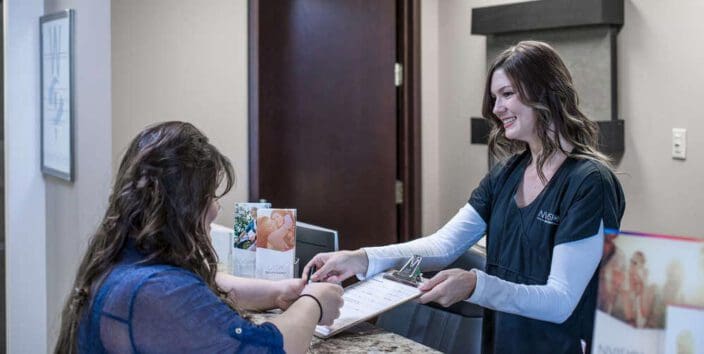
Medically Reviewed by Max Parikh, M.D.
Further Reading
How do They Do Cataract Surgery? Cataract Surgery from Pre-Op to Post-Op
Home / Guide to Cataract Surgery /
Last Updated:

Medically Reviewed by Max Parikh, M.D.
Understanding what happens during a cataract surgery may alleviate your fears and help you feel more comfortable with what is to come. This guide can help, as we outline all of the steps involved.
Table of Contents

Your surgery process will begin with an exam. The eyes will be extensively evaluated by examination and diagnostic testing to confirm a cataract surgery will benefit you. Laser surgery may be an option to reduce your astigmatism and assist with the removing of the cataract. Your doctor will make an incision to get to your cataract. Then, your doctor will break up your cataract.
Your cataract will be removed via one of two methods. Your lens will then be replaced. Then, your healing will begin.
Your Cataract Examination Comes First
A cataract is the clouding of the lens of the eye. While you may feel as though you could look into a mirror and diagnose a cataract yourself, a doctor must get involved in the diagnostic progress. That is why all cataract surgeries begin with an examination by a qualified ophthalmologist.
Mayo Clinic reports that a cataract screening exam has some elements that are similar to a traditional eye exam. For example, your doctor may review your medical history with you to ensure that new health conditions haven’t appeared since your last exam. Your doctor will also perform a visual acuity test to measure how well you can see a series of letters. If you’ve worn glasses or contact lenses, these eye examination steps may be familiar to you.
You deserve clear vision. We can help.
With 135+ locations and over 2.5 million procedures performed, our board-certified eye surgeons deliver results you can trust. Your journey to better vision starts here.
Your doctor may need to look even closer at your eyes in order to determine the depth of the cataract. The American Academy of Ophthalmology reports that your doctor may use a special microscope to examine your cornea, iris, and lens. Your doctor may also dilate your eyes, so an examination of the back of your eye can be performed.
The results of these tests can help your doctor to diagnose a cataract and ensure that your eyes are healthy enough for surgery. Test results can also help your doctor prepare for the type of surgery and lens you will need in order to see clearly after surgery.
If you have a cataract and your doctor feels surgery is the best option for you, your surgery may be scheduled at the end of the examination.
Step-by-Step Guide to Cataract Surgery
Here’s what happens once you’re on the operating table:
- Your surgeon administers a numbing injection or eye drops into your eye before the surgery.
- You may receive additional medication to keep you relaxed throughout the procedure.
- Using a blade or laser, the surgeon creates a small incision in your eye.
- The surgeon inserts a tiny ultrasound device into the incision and activates it to break up the lens with the cataract.
- Using a suction device, the surgeon removes the tiny lens fragments from your eye.
- The doctor inserts a new lens.
- Your surgeon decides whether stitches are needed to close the incision. (Some patients don’t need stitching.)
- You may need to wear a special shield over the treated eye.
- After a 15 to 30 minutes of rest, you may go home.
Step 1: Mapping Your Eye

There are two main ways to perform a cataract surgery. One involves a laser, and the other does not. If you do have surgery with a laser, you may have steps involved with your surgery that other patients do not.
At the beginning of a laser-assisted cataract surgery, your doctor places a combination camera/ultrasound imaging device over your eye. According to the American Academy of Ophthalmology, this device maps the shape and surface of your eye, and that information is sent to a computer. That computer calculates where your incisions should be located and how deep they should be.
Step 2: Softening Your Cataract
While cataracts involve clouding of the lens, they can also involve stiffening or hardening of the lens. A hard lens is somewhat harder for your doctor to remove during surgery, and you might need a slightly larger incision to allow your doctor to remove all lens pieces.
If you have a laser surgery procedure, the machine can use ultrasound waves to soften the lens before your surgery begins. This process can be done in conjunction with the mapping of your eye, according to the American Academy of Ophthalmology, and it takes just minutes to complete. It could make your surgery easier for your doctor to perform. It is only available with laser procedures.
Step 3: Making an Incision
In order to remove the cataract from your eye, your doctor must make a very small incision in your eye. By the time this cut is made, you will be under a form of anesthesia, so you will not feel the incision.
In a traditional surgery, your doctor makes this incision with a scalpel. According to the American Academy of Ophthalmology, an incision for cataract removal ranges in size from 1.6 mm to 3 mm long, and incisions are typically 0.3 mm deep.
In laser surgeries, the incision length and depth are dictated by the results of the mapping work done on your eye. Incisions made via laser may be longer or shorter than those made with a scalpel, depending on your eye and your cataract.
Step 4: Breaking Up Your Cataract
The technical term for this step, according to the U.S. National Library of Medicine, is phacoemulsification. Here, your doctor places a very small, pen-like device into the incision in your eye. When this device is activated, it emits sound waves. Those waves move through the lens and break it into pieces.
Some laser machines are capable of breaking up the lens without the use of phacoemulsification. In those situations, this sound-wave step is not needed.
If your cataract has advanced to the point where your lens can’t be broken up safely, your doctor may choose to remove your lens without breaking it up first. This type of surgery, according to the American Optometric Association, requires a slightly larger incision on the eye.
You deserve clear vision. We can help.
With 135+ locations and over 2.5 million procedures performed, our board-certified eye surgeons deliver results you can trust. Your journey to better vision starts here.
Step 5: Removing Your Cataract
When your lens is broken into sufficient pieces, your doctor uses a suction device to remove all of the lens pieces from your eye. In some cases, according to the American Society of Retina Specialists, small pieces of your lens remain after surgery. If that happens, you may experience:
- Blurred vision.
- Eye redness.
- Light sensitivity.
- Eye pain.
- Debris in your field of vision.
Your doctor may use eye drops or a second surgery to remove the fragments if this complication happens. Your doctor will examine your eyes closely as you heal to ensure this is not happening to you.
If your cataract was too advanced to be broken up safely, your doctor will use the incision on your eye to remove the lens in one piece. You will have a slightly larger incision with this type of surgery, but your risk of fragment retention will be smaller.
Step 6: Replacing Your Lens
With your damaged lens removed from your eye, it’s time to place a new lens inside of your eye to give you clear vision. As part of your examination before surgery, your doctor will describe the lens types available to you. Your doctor will help you decide which lens is right for your eye, your lifestyle, and your budget.
It is important to note that some lenses are considered advanced and cosmetic, and as a result, you may be required to pay a bit more for them. For example, the insurance company Cigna suggests that multifocal lenses and toric lenses are premium lenses that might be associated with higher costs.
Your doctor may not be an expert on your insurance plan and your coverage, but your doctor’s office can help you parse your coverage and understand your financial obligations so you can make a smart choice.

Typically, cataract surgery is covered by insurance and Medicare. However, in the event that your procedure is not fully covered, or if you elect to choose an upgraded lens option as part of your treatment plan, NVISION® offers financing options to ensure that you are not inhibited by cost. Read on to learn more about CareCredit® and see how cataract surgery can be affordable.
Learn More
Step 7: Your Healing Begins
A cataract surgery takes minutes to complete, and when it is through, you will be escorted to a recovery area. The American Academy of Ophthalmology reports that you will be asked to stay in this area for 15 to 30 minutes. This allows you to recover from the anesthesia used during the procedure, and it gives your doctor an opportunity to examine your eye once more before you go home to rest.

You will be given medications to help your eye heal, and your doctor will fit you with a patch to protect your eye. Your doctor will schedule your follow-up appointments and explain your at-home care instructions. You will need someone to drive you home, and it’s wise to have this person listen in on the instructions from your doctor.
Following Up After Surgery
- Your ophthalmologist may schedule several eye checkup appointments, beginning a day or two after your surgery.
- If you experience any post-surgery complications, including persistent pain, vision loss or swollen eyelids, contact your surgeon’s office immediately.
- If your doctor is not available or is unable to see you, visit an urgent care facility. If you need emergency care, the urgent care physicians will provide it or else get you to the nearest emergency room. (ER visits after eye surgery are extremely rare.)
- Your ophthalmologist will continue monitoring your eye and advice you on when you can safely resume your normal routine, such as driving or exercise.
You likely will be asked to follow these self-care instructions during your recovery period:
- Use prescription eye drops to prevent eye inflammation and infection.
- Use over the counter painkillers to manage non-chronic discomforts in your eye.
- Your surgeon may ask you to use a protective eye shield to prevent injury due to rubbing or pressure.
- Avoid rubbing or pressing on the eye.
- Wear eyeglasses for an undefined period – probably until the doctor says during a follow-up visit that you can stop wearing them.
- Keep soap and water out of your recovering eye. Use only your prescribed eyedrops.
Your eye should completely heal in roughly eight weeks after surgery. Your vision will have improved significantly by then.
Here’s what can happen after complete recovery has occurred:
- Your ophthalmologist may give you an eyeglass prescription based on your visual health.
- If also the other eye has a cataract, your doctor can schedule surgery to treat it.
Work With a Doctor You Can Trust
Cataract surgeries can be delicate, and it is natural to feel a little nervous about what will happen when you are under the care of your doctor. We can help.
At NVISION, we prioritize your comfort. We work with compassionate doctors who explain procedures clearly, and we follow all protocols to keep you safe. We would love to introduce you to our doctors, our technology, and our brand. Please contact us.
The Patient Experience

Exceptional outcomes. The gold standard in patient care. The #1 Choice of Eye Doctors®. The Vision For Life promise. That’s what makes the NVISION® experience like no other.
Learn More
You deserve clear vision. We can help.
With 135+ locations and over 2.5 million procedures performed, our board-certified eye surgeons deliver results you can trust. Your journey to better vision starts here.
References
- Cataracts: Diagnosis and Treatment. Mayo Clinic.
- Cataract Diagnosis and Treatment. (May 2018). American Academy of Ophthalmology.
- Traditional Cataract Surgery vs. Laser-Assisted Cataract Surgery. (August 2017). American Academy of Ophthalmology.
- How to Perform Manual Small-Incision Cataract Surgery. (June 2010). American Academy of Ophthalmology.
- Cataract Removal. U.S. National Library of Medicine.
- Cataract Surgery. American Optometric Association.
- Retained Lens Fragments. (2016). American Society of Retina Specialists.
- Intraocular Lens (IOL) Implants. (December 2017). Cigna.
- Cataract Surgery. American Academy of Ophthalmology.

As the founding partner of the Advanced Ophthalmology Institute in 1999 and the former Los Angeles (previously San Diego) Chargers’ team ophthalmologist for over a decade, Dr. Parikh knows the value of precision and the outcomes in vision enhancement surgery.
This content is for informational purposes only. It may have been reviewed by a licensed physician, but is not intended to serve as a substitute for professional medical advice. Always consult your healthcare provider with any health concerns. For more, read our Privacy Policy and Editorial Policy.